United Homes Group stock plunges after Nikki Haley, directors resign
Introduction & Market Context
Pebblebrook Hotel Trust (NYSE:PEB) released its May 2025 investor presentation highlighting the company’s strategic portfolio transformation and significant growth opportunities despite trading at a substantial discount to its estimated net asset value (NAV). The presentation comes after a challenging fourth quarter of 2024, where the company missed EPS expectations but exceeded revenue forecasts. Currently trading at $9.14 per share, Pebblebrook is emphasizing its position as the largest owner of urban and resort lifestyle hotels in the United States with 46 properties across 13 markets.
The company’s presentation outlines a comprehensive overview of its portfolio, which maintains a balanced 50/50 business/leisure customer mix while showcasing completed investments and future growth opportunities.
As shown in the following overview of Pebblebrook’s portfolio and key metrics:
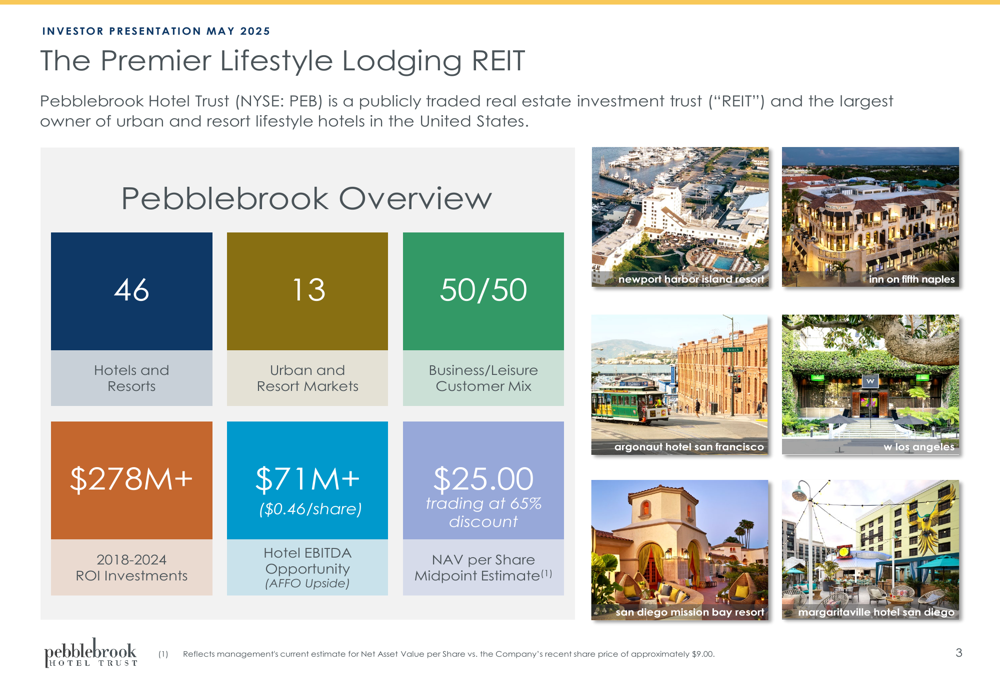
Strategic Portfolio Transformation
A central theme of Pebblebrook’s presentation is its strategic shift from urban to resort properties, significantly reducing exposure to challenging urban markets, particularly on the West Coast. Since 2019, the company has acquired five upper upscale and luxury resorts for $802 million while divesting 15 lower-quality urban properties for $1.2 billion.
This transformation has dramatically altered Pebblebrook’s EBITDA composition, with resort properties now contributing 45% of EBITDA (up from 17% in 2019) while urban properties’ contribution has decreased to 55% (down from 83%). Geographically, East Coast properties now generate 54% of EBITDA (up from 38%), while West Coast exposure has declined to 43% (from 56%).
The following map and guest segmentation chart illustrate Pebblebrook’s current portfolio distribution and customer mix:
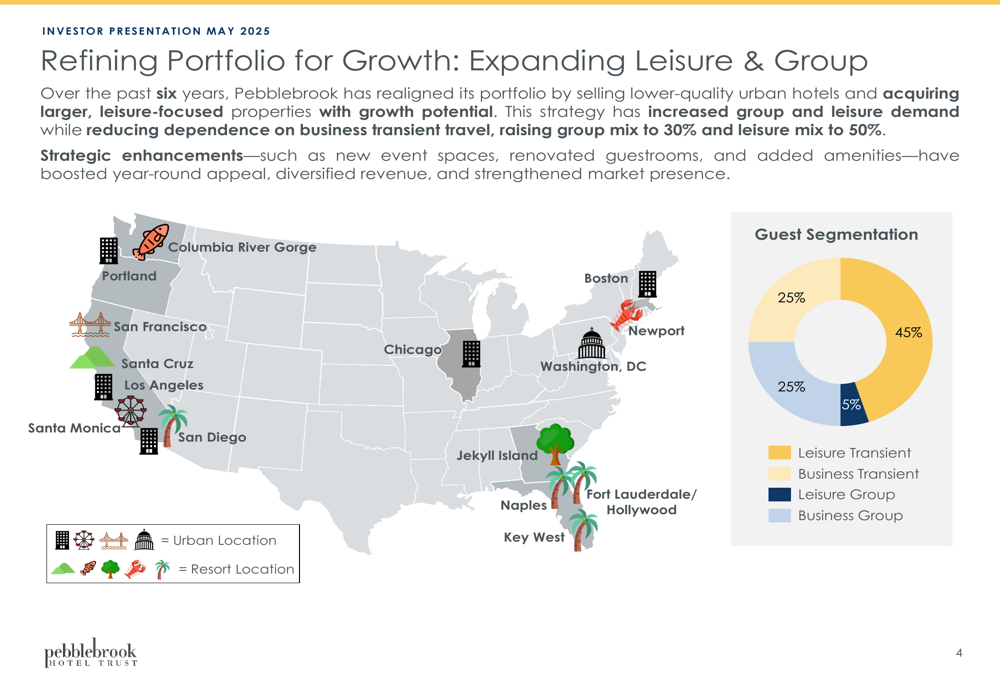
The company’s market repositioning strategy is clearly demonstrated in this EBITDA contribution comparison between 2019 and 2024:

Growth Opportunities
Pebblebrook identifies significant growth opportunities through continued urban market recovery and returns from its strategic redevelopment investments. The presentation outlines a potential $71 million in additional Hotel EBITDA ($0.46 per share in AFFO upside), with $45 million expected from urban market recovery, $10 million from redevelopment projects, and $16 million from the LaPlaya Beach Resort.
The following chart illustrates this EBITDA growth opportunity:
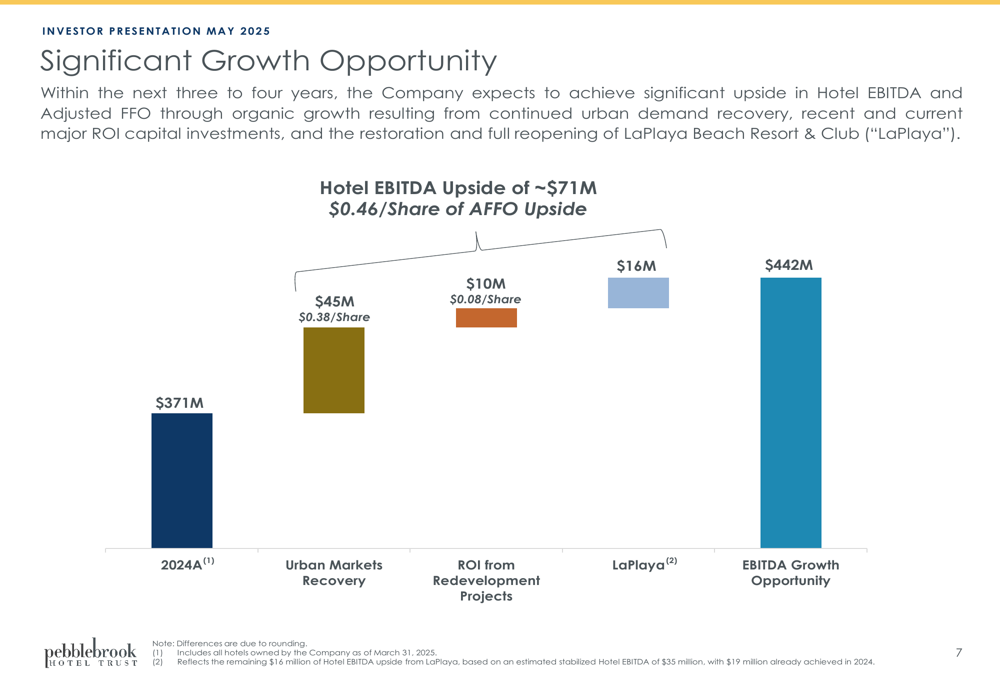
For urban markets specifically, Pebblebrook anticipates a $45+ million increase in Urban Hotel EBITDA over the next three to four years as occupancy levels, which remain below pre-pandemic benchmarks, continue to recover. The company’s assumptions include occupancy rising to 80% (still below 2019 levels of 83%) and modest ADR growth of 3%.
The detailed urban recovery data is presented in the following table:
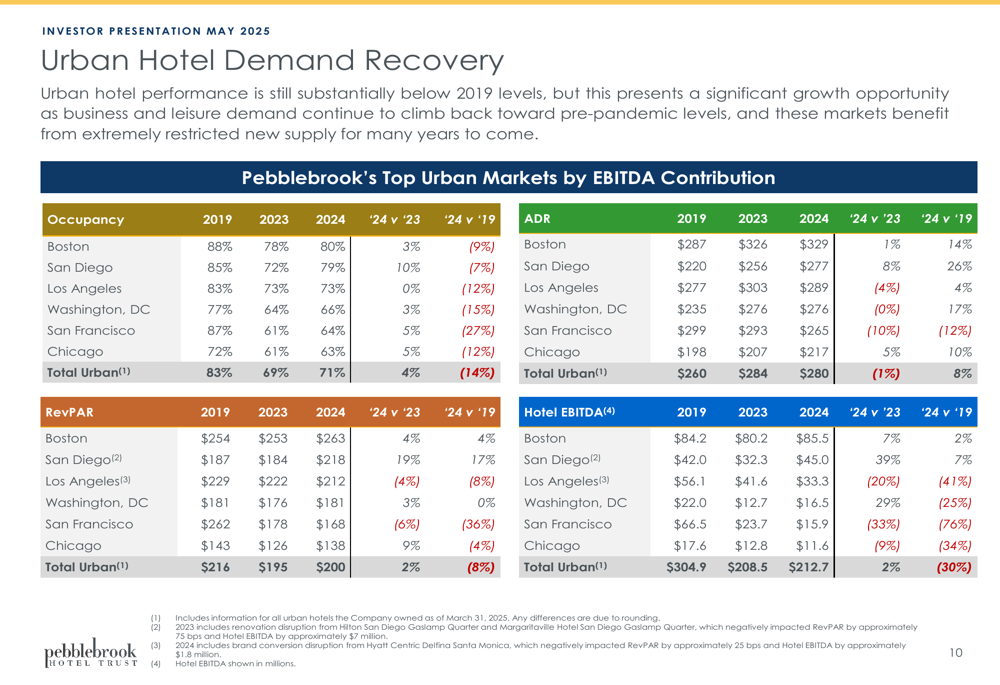
ROI Investments Driving Growth
Pebblebrook has invested $278 million in ROI capital projects between 2018-2024, which it estimates will generate annual stabilized EBITDA gains of $29-33 million. With approximately $21-22 million in annualized ROI already realized through 2024, the company anticipates achieving an additional $8-11 million in returns upon stabilization over the next few years.
The company’s track record with redevelopment projects is detailed in this table:
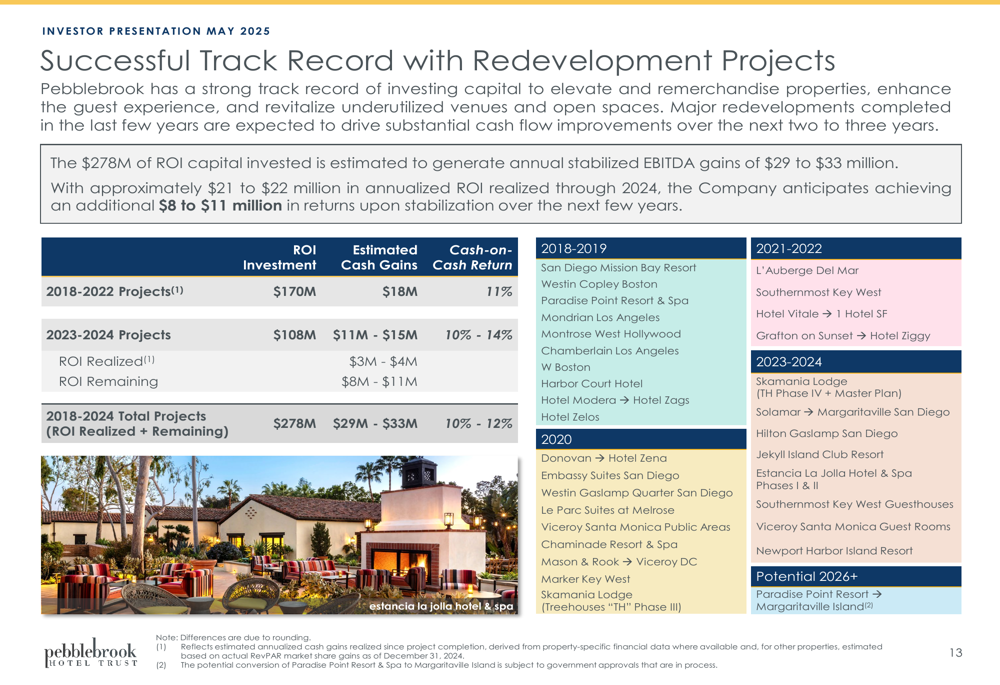
LaPlaya Beach Resort Recovery
A significant focus of the presentation is the recovery and reinvestment at LaPlaya Beach Resort & Club following hurricane damage. In January 2025, the company reopened the Beach House upper floors and rooms, with substantial completion of the remaining 20 first-floor Beach House guestrooms expected in Q2 2025.
The property generated $19 million in hotel EBITDA in 2024 and received $23.8 million in business interruption insurance proceeds. For Q1 2025, LaPlaya achieved $10.8 million in hotel EBITDA and received $4.3 million in insurance proceeds. The 2025 outlook projects an additional $13-15 million in hotel EBITDA for the remainder of the year.
The LaPlaya recovery progress and outlook are summarized here:
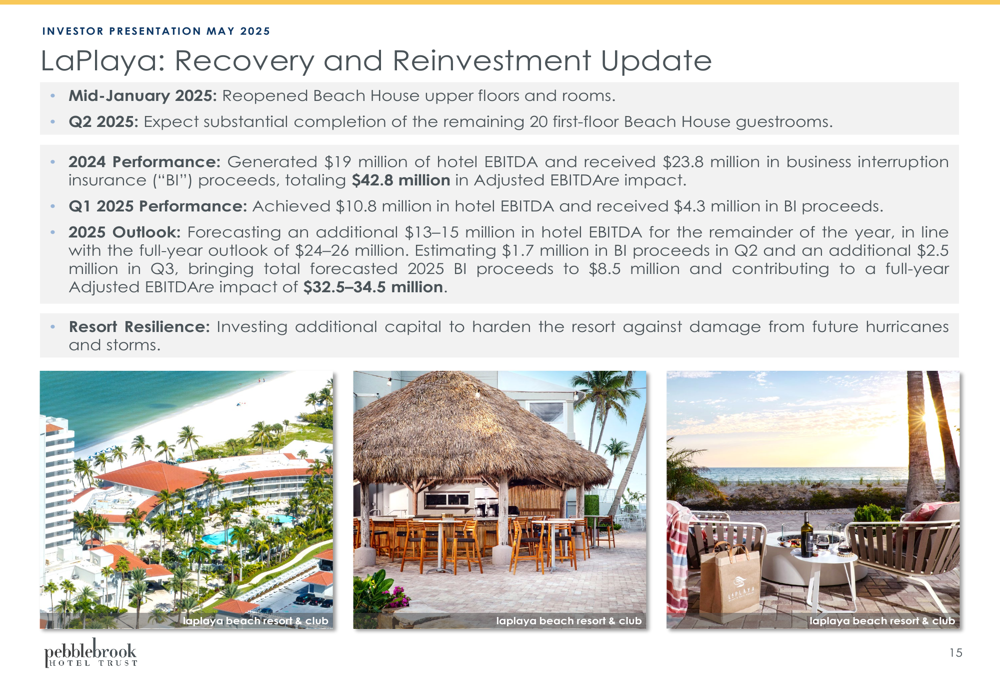
Financial Position and NAV Discount
Perhaps the most striking aspect of Pebblebrook’s presentation is the highlighted discount to NAV. At a share price of approximately $9.00, the company calculates it is trading at a 65% discount to its estimated private market valuation of $25.00 per share. This significant discount persists despite the company’s strong liquidity position and managed debt profile.
As of March 31, 2025, Pebblebrook reported $218.2 million in cash plus $642.6 million of undrawn availability on its $650 million credit facility. The company’s weighted-average interest rate is 4.2%, with a weighted-average debt maturity of approximately 2.8 years and no meaningful debt maturities until December 2026.
The NAV discount analysis is presented in detail here:
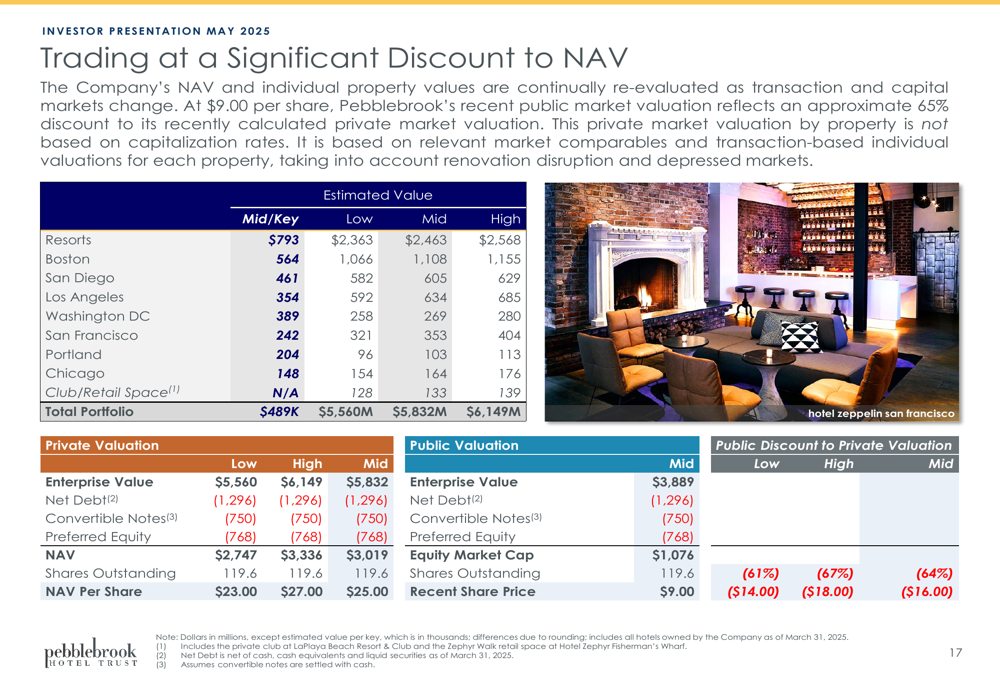
The company’s debt maturity schedule and balance sheet strength are illustrated in this chart:
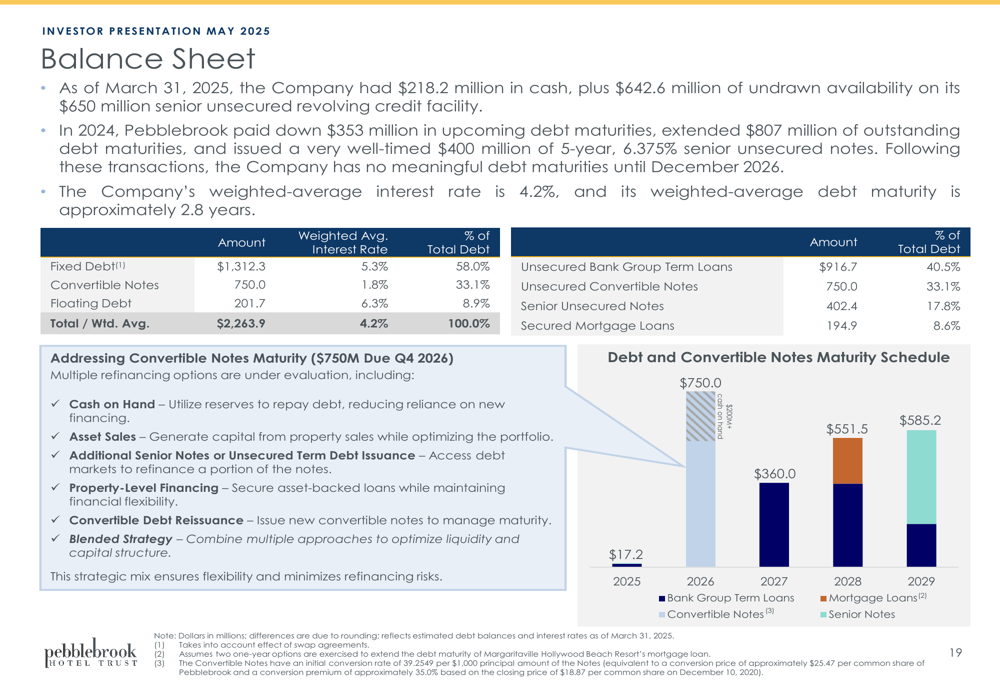
Forward-Looking Statements
Pebblebrook’s presentation outlines several reasons for investor optimism, including strong RevPAR growth and market share gains from ROI-related redevelopments, continued urban market demand recovery, and the significant discount to estimated private market NAV.
However, these forward-looking statements should be considered alongside the company’s recent performance. In Q4 2024, Pebblebrook reported an EPS of -0.51, missing the forecast of -0.38, though revenue exceeded projections at $337.6 million compared to the anticipated $324.03 million.
The company faces ongoing challenges in key markets like San Francisco and Los Angeles, with the latter impacted by wildfires that are expected to affect Q1 revenue by $8.5-$11 million. Despite these challenges, management remains confident in the long-term recovery potential, with CEO John Bortz stating in the Q4 earnings call that market recovery is "not a matter of if, it is a matter of when."
Pebblebrook’s strategic transformation from urban to resort properties, combined with its ROI investments and the ongoing recovery at LaPlaya Beach Resort, positions the company to potentially capitalize on the significant gap between its current trading price and estimated private market value as urban markets continue their gradual recovery.
Full presentation:
This article was generated with the support of AI and reviewed by an editor. For more information see our T&C.
